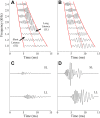Medial olivocochlear reflex effects on amplitude growth functions of long- and short-latency components of click-evoked otoacoustic emissions in humans
- PMID: 33625926
- PMCID: PMC8356769
- DOI: 10.1152/jn.00410.2020
Medial olivocochlear reflex effects on amplitude growth functions of long- and short-latency components of click-evoked otoacoustic emissions in humans
Abstract
Functional outcomes of medial olivocochlear reflex (MOCR) activation, such as improved hearing in background noise and protection from noise damage, involve moderate to high sound levels. Previous noninvasive measurements of MOCR in humans focused primarily on otoacoustic emissions (OAEs) evoked at low sound levels. Interpreting MOCR effects on OAEs at higher levels is complicated by the possibility of the middle-ear muscle reflex and by components of OAEs arising from different locations along the length of the cochlear spiral. We overcame these issues by presenting click stimuli at a very slow rate and by time-frequency windowing the resulting click-evoked (CE)OAEs into short-latency (SL) and long-latency (LL) components. We characterized the effects of MOCR on CEOAE components using multiple measures to more comprehensively assess these effects throughout much of the dynamic range of hearing. These measures included CEOAE amplitude attenuation, equivalent input attenuation, phase, and slope of growth functions. Results show that MOCR effects are smaller on SL components than LL components, consistent with SL components being generated slightly basal of the characteristic frequency region. Amplitude attenuation measures showed the largest effects at the lowest stimulus levels, but slope change and equivalent input attenuation measures did not decrease at higher stimulus levels. These latter measures are less commonly reported and may provide insight into the variability in listening performance and noise susceptibility seen across individuals.NEW & NOTEWORTHY The auditory efferent system, operating at moderate to high sound levels, may improve hearing in background noise and provide protection from noise damage. We used otoacoustic emissions to measure these efferent effects across a wide range of sound levels and identified level-dependent and independent effects. Previous reports have focused on level-dependent measures. The level-independent effects identified here may provide new insights into the functional relevance of auditory efferent activity in humans.
Keywords: auditory; efferent; medial olivocochlear; otoacoustic emissions.
Conflict of interest statement
No conflicts of interest, financial or otherwise, are declared by the authors.
Figures







Similar articles
-
Otoacoustic-emission-based medial-olivocochlear reflex assays for humans.J Acoust Soc Am. 2014 Nov;136(5):2697-713. doi: 10.1121/1.4896745. J Acoust Soc Am. 2014. PMID: 25373970 Free PMC article.
-
Increased medial olivocochlear reflex strength in normal-hearing, noise-exposed humans.PLoS One. 2017 Sep 8;12(9):e0184036. doi: 10.1371/journal.pone.0184036. eCollection 2017. PLoS One. 2017. PMID: 28886123 Free PMC article.
-
The medial olivocochlear reflex in children during active listening.Int J Audiol. 2015 Aug;54(8):518-23. doi: 10.3109/14992027.2015.1008105. Epub 2015 Mar 3. Int J Audiol. 2015. PMID: 25735203 Free PMC article.
-
The role of the medial olivocochlear reflex in psychophysical masking and intensity resolution in humans: a review.J Neurophysiol. 2021 Jun 1;125(6):2279-2308. doi: 10.1152/jn.00672.2020. Epub 2021 Apr 28. J Neurophysiol. 2021. PMID: 33909513 Free PMC article. Review.
-
Experimental and clinical aspects of the efferent auditory system.Acta Neurochir Suppl. 2007;97(Pt 2):419-24. doi: 10.1007/978-3-211-33081-4_47. Acta Neurochir Suppl. 2007. PMID: 17691330 Review.
Cited by
-
Neural Fluctuation Contrast as a Code for Complex Sounds: The Role and Control of Peripheral Nonlinearities.Hear Res. 2024 Mar 1;443:108966. doi: 10.1016/j.heares.2024.108966. Epub 2024 Feb 1. Hear Res. 2024. PMID: 38310710 Free PMC article. Review.
-
Effects of contralateral noise on envelope-following responses, auditory-nerve compound action potentials, and otoacoustic emissions measured simultaneously.J Acoust Soc Am. 2024 Mar 1;155(3):1813-1824. doi: 10.1121/10.0025137. J Acoust Soc Am. 2024. PMID: 38445988 Free PMC article.
-
The Origin Along the Cochlea of Otoacoustic Emissions Evoked by Mid-Frequency Tone Pips.J Assoc Res Otolaryngol. 2024 Aug;25(4):363-376. doi: 10.1007/s10162-024-00955-0. Epub 2024 Jun 27. J Assoc Res Otolaryngol. 2024. PMID: 38937327 Free PMC article.
-
Human Olivocochlear Effects: A Statistical Detection Approach Applied to the Cochlear Microphonic Evoked by Swept Tones.J Assoc Res Otolaryngol. 2024 Oct;25(5):451-475. doi: 10.1007/s10162-024-00956-z. Epub 2024 Jul 1. J Assoc Res Otolaryngol. 2024. PMID: 38954166
-
A Time-Course-Based Estimation of the Human Medial Olivocochlear Reflex Function Using Clicks.Front Neurosci. 2021 Oct 28;15:746821. doi: 10.3389/fnins.2021.746821. eCollection 2021. Front Neurosci. 2021. PMID: 34776849 Free PMC article.
References
-
- Guinan JJ Jr.Physiology of olivocochlear efferents. In: The Cochlea, edited by Dallos PJ, Popper AN, Fay RR.. New York: Springer-Verlag, 1996, p. 435–502. doi:10.1007/978-1-4612-0757-3_8. - DOI
Publication types
MeSH terms
Grants and funding
LinkOut - more resources
Full Text Sources
Other Literature Sources

